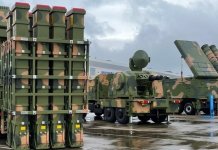As Russia continues to explore options for new classes of aircraft carrier, an ambitious supercarrier with a maximum displacement of 100,000 tons is also under consideration, according to various media reports including the Russian news agency – TASS.
Donald Trump Incited Indian PM Narendra Modi To Revoke Article 370 From Kashmir – US Report
According to reports, an unprecedented semi-catamaran design is under active consideration to meet some of the Russian Navy’s requirements. An official of the Krylov Scientific Center, which played a significant role in developing the design stated:
“The project is characterised by the underwater part of a semi-catamaran form… Catamaran actually means two hulls united by a platform. It has a wide deck which is important for an aircraft carrier. The design adds flight deck space on which the number of aircraft depends. Such a design has never been used for aircraft carriers. “The zest of the carrier is below the waterline,” the official said.
The light carrier will displace about 40,000 to 45,000 tons which is less than half the displacement of a U.S. Ford-class carrier. It will be about 1,000-feet long, with a maximum speed of 28 knots using gas-turbine propulsion and an at-sea endurance of 60 days.
The new aircraft carrier will carry an air wing of 24 to 28 Su-33 and MiG-29K), four airborne early warning aircraft and about a dozen Ka-27 helicopters. Again, that’s about half the air complement of a U.S. aircraft carrier. The ship will be armed with Pantsir-ME anti-aircraft missiles, as well as anti-submarine weapons and electronic warfare equipment.
Media reports call the light carrier’s mission as maintaining “combat sustainability of navy forces and groups in blue and green [coastal] waters by providing air and missile defence and destroying air, surface, underwater and coastal targets.”
Can China’s Robotic Submarines Match the US Naval Might in the South China Sea?
But why a catamaran design instead of a conventional flat-top or ski-jump carrier? “Catamarans offer the advantages of reduced drag which permit catamarans to attain speeds not possible with a monohull and/or the option of being equipped with less powerful and therefore less expensive engines,” according to GlobalSecurity.org. “
Due to their relatively great length in relation to their width, a catamaran is able to travel at high speed and has excellent lateral stability.” However, the biggest concern with the design is that it is significantly less stable in rough seas and from a propensity for submarining their forward hulls into large head seas which can result in the forward end of the hull ‘digging in’ and the vessel flipping end for end,” GlobalSecurity says.




